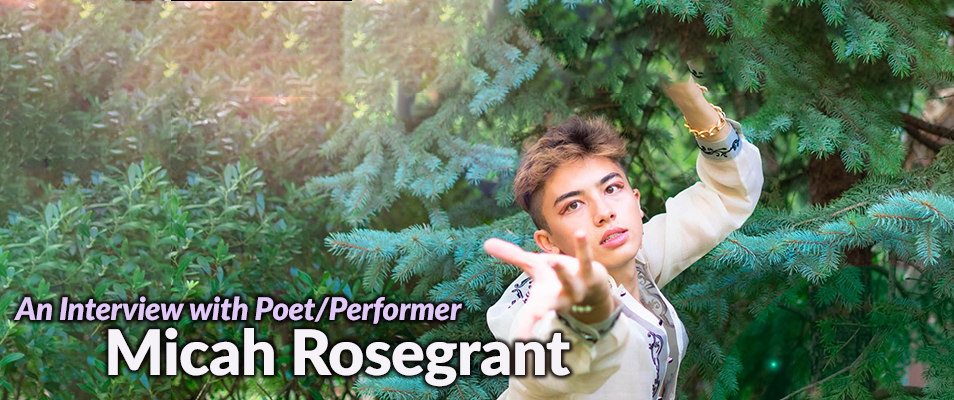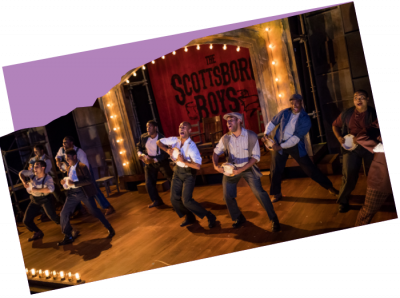Your donation sets the stage for a new season of Boston's most intimate, entertaining and provocative plays and musicals. Our shows make powerful connections with our audiences-- and they are only possible because of you.
An Interview with Poet/ Performer Micah Rosegrant




An Interview with Poet/ Performer Micah Rosegrant
A published poet, a sold-out solo show, a prestigious fellowship with Arts Connect International, co-founding a theatre company… and still finishing up their senior year at Boston University. Micah Rosegrant, recently featured in our Emerging Theatre Leaders panel, is already taking the Boston theatre scene by storm: uplifting marginalized voices and challenging the status quo. As we head into our second week of Play Discussion Club Series 5 with Micah as our host, we asked them a few questions about their work and why they chose these four plays to share with our community.
Tell us a little bit about your background and your work thus far as an artist.
I am a words-worker who descends from farms on the lands currently known as the United States and the Philippines. Through mediums like poetry, oral history, and theatre, I tell stories that center ancestry and queer divinity as a means of displacing the ideologies that call for the extinction of my blood and chosen families. As an Artist in Community Fellow at Arts Connect International, I am co-creating art by/for/with community while working to dismantle oppression within the American arts & culture sector. In addition, I co-founded Asian American Theatre Artists of Boston (AATAB) with Sarah Shin, serve on the Asian Pacific Islander Arts Network steering committee, advise the StageSource board, and write/speak/perform as a freelance artist.
You recently debuted your own one person show — The First Pineapple and Other Folktales — at the outdoor Starlight Square sponsored by Central Square Theater and the City of Cambridge. Tell us about the show and your experience performing the piece.
I describe The First Pineapple and Other Folktales as a “ritual of memory” that is summoned when my body—a queer mestizx bayoguin—is asked to perform on an Amerikan stage. The play changes each time I perform it because I change between each time I perform it, literally re-writing entire sections to address new relationships, experiences, and learnings. The play—informed by the autotheory tradition of folx like Maggie Nelson, Frantz Fanon, James Baldwin, and Ocean Vuong—uses my birth and life’s tethers to storytelling as a site for community to excavate our relationships to time, history, healing, and (of course) folktale. But none of the play is possible without the live performance in the shared time / space / energy of other humans. Witnesses are who make theatre a sacred space, so it was a literal blessing to perform this piece safely for two socially-distanced and masked nights. I am grateful to everyone who made that possible, from our brilliant creative team and everyone at Central Square Theater to every person who came and followed all the necessary protocols.
The title for this new installment of the SpeakEasy Play Discussion Group session you are moderating is Honoring Asian Diaspora Storytelling. For those who might be unfamiliar with the history, what events/periods are included in the term Asian Diaspora?
I crafted the nomenclature for this series with the trickiness of this very question in mind. In America, we often talk about “Asian” stories and people without interrogating what “Asian” means and why it exists as a framework. Part of what I want to draw attention to in this series is the irony of trying to talk about “Asian” anything when the continent of Asia holds over 30 different nationalities, each with unique constructions of ethnicity, gender, class, Indigeneity, etc. We must hold that truth alongside the history that “Asian American” has been formed as a sociopolitical identity under which our communities organize and build solidarity with other global liberation movements. With that context in mind, the term “Asian Diaspora” loosely embraces all events and periods in which peoples from the continent of Asia have moved across geographic space and time. I think the play discussion series we’ve curated offers an opportunity to explore and complicate what this enormous framework means, and to relish in the ways this vastness manifests in the stories told by theatre artists who descend from Asia.
What plays will be read and how and why were they chosen?
We started off with Anchuli Felicia King’s White Pearl, a striking workplace comedy that explores Asia’s skin whitening industry and displays the global scale of anti-blackness as it intersects with capitalism. In curating this series, I knew I wanted to begin with a non-American Asian playwright writing about non-American Asian characters. In America, we tend to only perceive Asian personhood through American contexts: stories of refugees and immigrants, stories of diaspora, stories of Asian America told by Asian Americans. This is not a “bad” thing by any means, especially since those are the people and stories of our communities; but we can’t exclusively explore Asian American narratives if we are truthfully investing in Asian diaspora stories. I love amplifying work that locally challenges what Chimamanda Ngozi Adichie describes as “the danger of a single story.”
And that philosophy carries us to our next play: Roger Q. Mason’s brilliant new performance text Lavender Men, a fantasia that queers our understanding of history by investigating Abraham Lincoln’s relationship to Elmer Ellsworth. I was blessed to walk (masked and socially distant) with Roger recently to the Santa Monica pier, where we witnessed a stranger perform a ritual for themself in the water. Roger said to me, “You see that? Not just the event, but that no one else saw it…that’s what my play is about: how we are invisible. They don’t see us”. The magic of this play, the magic of ‘visibilizing’ the historically erased…that is why I love Roger’s work and why I’m excited to bring it to SpeakEasy.
After taking a necessary break for election week, we return to the series with Madhuri Shekar’s House of Joy, which I had the joy of witnessing in a filmed format from San Diego Rep’s COVID-closed production. This show moved me across many fronts, and I chose it for this series for the beauty of its language, characters, and intricate relationships. This play offers us a fictionalized slice of space-time in which we can viscerally process empire, war, and the exploitation of women and non-men.
Finally, we conclude with Seayoung Yim’s Do It For Umma. I wanted to end the series with a writer who is connected to the New England area, and my fierce co-conspirator (co-founder of AATAB) Sarah Shin recommended Seayoung—and this play—to me. Seayoung is a brilliant playwright from Seattle currently pursuing her MFA in Playwriting at Brown University, and I love how she plays with Shakespeare’s Hamlet to tell a story of how one community moves through loss and grief. I hate the word “timely”, but I can’t help but appreciate how resonant this play feels as I continue to process the deaths of my grandmother and other beloved elders this year. I look to theatre as one medium in which I can move through grief, and this year the world is especially abundant with grief.
Several of the playwrights will be joining the Zoom discussion of their play. How does a playwright’s participation affect the conversation around their plays?
As we build a more inclusive arts and culture sector, we need more platforms for all artists to speak about their work, especially when an artist’s work is made from a lived experience that is distant, on some axis, from their audiences’ lived experiences. I guess that is a complicated way of saying that under capitalism, there is a violent history of communities’ stories being stolen for profit. In reckoning with that legacy in the American theatre, we need to not only empower historically marginalized communities to tell their own stories, but also create the time and space for witnesses to join in community with those storytellers. I am excited that we are doing that through this series. Having a playwright present to discuss their work enriches our ability to better understand and appreciate the contexts from which the play emerged. Plus, we receive the gift of meeting a new person and separating them from their writing. As someone who works in autotheory, I love opportunities to meet people outside the world of my art because it allows them to see that I am ultimately unique from the stories I put on stage, even when that story is of my self.


Are there any themes or characteristics common to an Asian Diaspora play/story?
While I remind we must problematize any attempt to identify common characteristics across an “Asian” anything, I think we can look for trends or patterns across Asian Diaspora stories and their telling. Different Asian diasporas are impacted by empire and capitalism in similar ways, and so I think we get interested in certain shared lived experiences and stories, especially when meeting each other against the unique colonial backdrop of America. For a microcosmic example, I think a lot of us who grew up in predominantly white areas experienced bullying because of the foods we brought to school, and so I wonder if we (consciously or subconsciously) incorporate food in our stories as a means of reclaiming that hurt. Or perhaps we depict food because our cultures have unique and specific traditions of eating that become important to us. Or maybe our food-integrated narratives are reactions to the way specific Americans in our lives have exoticized us as consumable because they’ve only met “Asian-ness” through our foods. Ultimately, I imagine the truth is a mix of all those conjectures and then some. On a more abstract level, I notice that many Asian Diaspora storytellers are interested in history, geography, and metatheatre; plays like Sara Porkalob’s Dragon Cycle, Celine Song’s Endlings, Chay Yew’s A Language of Their Own, David Henry Hwang’s Soft Power, and basically all the plays in our series poke and prod at time, space, memory, and who gets to tell what story. I hypothesize this descends from our relationships to migration—either our own, or that of our ancestors.
How did you get your start as a playwright?
I was extraordinarily lucky to grow up around, and with, communities of artists in Northern Virginia before moving to Boston for undergrad. I had the class privilege to participate in programs at Acting For Young People (AFYP), which is an incredible incubator for—as the name suggests—young people who are interested in acting. I got to explore many facets of theatre from a young age, and I think this early exposure to storytelling and how storytelling changes and nurtures people was absolutely fundamental to my growth into playwriting. I also had many opportunities to explore storytelling through forensics (speech & debate), broadcast journalism, and theatre at Chantilly High School. Then, my voice as a writer was cultivated by visionary artists who I met in and out of Boston University’s School of Theatre: folx like Kirsten Greenidge, Sara Porkalob, Diana Oh, Ireon Roach, and Kristin Leahey—just to name a few. Kirsten Greenidge nurtures new voices in the American theatre in a way that every young writer deserves to experience. Through listening and trust, she innovates what it means to support students and community; she teaches us how to find our voices and how to love them.
Who are the writers who have influenced your work?
I love this question because it gives me a chance to sing praises to writers who make my work possible, and I get frustrated when answering this question because I know I won’t be able to ever answer it completely. The truth is that every author I experience impacts my work. From aunties on family email to dissertations I read for class to freestyles I watch on youtube (or sometimes in person), I think my witnessing of how humans communicate has the largest influence on my work. That said, I’ll name some writers whose work repeatedly inspires me to write, learn more, and write again: Ocean Vuong, Danez Smith, Barbara Jane Reyes, torrin a. greathouse, Dane Figueroa Edidi, Porsha Olayiwola, Hanif Abdurraqib, Golden, Audre Lorde, adrienne maree brown, Maggie Nelson, James Baldwin, Ruby Ibarra, CHIKA, Suzan-Lori Parks, and Franny Choi.
How have you been spending your downtime during the pandemic?
I’ve been trying to shift the nomenclature through which I speak about living, and so I wouldn’t call any of what I’ve been doing amidst pandemic “downtime”. I think rest is active. I think doing things for pleasure is active. I think learning is active. All of those verbs are as crucial to my life as my community organizing, schoolwork, and artistic practice. I meditate and practice yoga way more. I’ve gotten really invested in dismantling what I was taught about health and weight, and replacing those mostly harmful mindsets with new learning about what wellness looks like. In terms of media, I spend time each day on Instagram and Twitter because they serve as important platforms for news, art, public discourse, keeping in touch with community, meeting new people, and forming aesthetics. For stories, I have been engaging with HBO’s new content from Legendary and Lovecraft Country to Yvonne Orji: Momma, I Made It! and I May Destroy You and more. I love seeing queer and trans people living in both fiction and non-fiction. And I’ve been trying to live more in nature. I take long walks and find time each day to sit outside and listen. Sifting through my thoughts, conversing with earth and ancestors, and spending time with beloved blood and chosen family have all been silver linings amidst this year.
 Past Productions
Past Productions LAUGHS IN SPANISH
LAUGHS IN SPANISH PRU PAYNE
PRU PAYNE ain't no mo'
ain't no mo' a man of no importance
a man of no importance JAJA’S AFRICAN HAIR BRAIDING
JAJA’S AFRICAN HAIR BRAIDING




